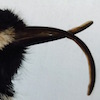 Novel Picornavirus Associated with Avian Keratin Disorder in Alaskan Birds
Novel Picornavirus Associated with Avian Keratin Disorder in Alaskan BirdsMaxine Zylberberg, Caroline Van Hemert, John P. Dumbacher, Colleen M. Handel, Tarik Tihan, Joseph L. DeRisi
mBio 2016Abstract: Avian keratin disorder (AKD), characterized by debilitating overgrowth of the avian beak, was first documented in
black-capped chickadees (Poecile atricapillus) in Alaska. Subsequently, similar deformities have appeared in numerous species
across continents. Despite the widespread distribution of this emerging pathology, the cause of AKD remains elusive. As a result,
it is unknown whether suspected cases of AKD in the afflicted species are causally linked, and the impacts of this pathology at the
population and community levels are difficult to evaluate. We applied unbiased, metagenomic next-generation sequencing to
search for candidate pathogens in birds affected with AKD. We identified and sequenced the complete coding region of a novel
picornavirus, which we are calling poecivirus. Subsequent screening of 19 AKD-affected black-capped chickadees and 9 control
individuals for the presence of poecivirus revealed that 19/19 (100%) AKD-affected individuals were positive, while only 2/9
(22%) control individuals were infected with poecivirus. Two northwestern crows (Corvus caurinus) and two red-breasted nuthatches
(Sitta canadensis) with AKD-consistent pathology also tested positive for poecivirus. We suggest that poecivirus is a
candidate etiological agent of AKD.
